The red colour of perennials may range from bright or vibrant red to dark maroon, from rich to rusty red, from crimson, cherry, cerise or deep wine to scarlet, carmine and ruby-red or even salmon. Some shades of red are difficult to place among other plants. Garden writers recommend companions for many red-flowered perennials as you will see below. The myriad ideas suggested will make your partnership choices somewhat easier.
* Watch for the animated hummingbird and butterfly with the plants that attract them. *
The deer icon indicates plants that deer are not usually attracted to.
   The best time and method to propagate plants can be found on our image-intensive PROPAGATION page.
To help your plants grow their best, check out our FERTILIZATION page.
To create your own plant partnerships based on tried and true color theory, check out our GARDEN COLOR page.
To see if a particular plant is on this page press Ctrl+F, type in the name, then click the Find button.
The best time and method to propagate plants can be found on our image-intensive PROPAGATION page.
To help your plants grow their best, check out our FERTILIZATION page.
To create your own plant partnerships based on tried and true color theory, check out our GARDEN COLOR page.
To see if a particular plant is on this page press Ctrl+F, type in the name, then click the Find button.
ACHILLEA
 Aromatic foliage is only one of many desirable features of most Yarrows, in addition to their drought-tolerance. Given a place in full sun with well-drained soil, they will provide a long season of bloom. The only problem might be the speed at which many forms spread out. Divide them every 3-5 years in early spring or fall to curb their enthusiasm.
Achillea: Yarrow, red
Aromatic foliage is only one of many desirable features of most Yarrows, in addition to their drought-tolerance. Given a place in full sun with well-drained soil, they will provide a long season of bloom. The only problem might be the speed at which many forms spread out. Divide them every 3-5 years in early spring or fall to curb their enthusiasm.
Achillea: Yarrow, red

with: Chrysanthemum x superbum
Achillea 'Red Beauty': bright red, 20"
between: Rudbeckia fulgida 'Goldsturm' & Phlox paniculata 'White Admiral'
in front of: Echinops ritro
behind: Astilbe x arendsii, Chrysanthemum x superbum 'Alaska', Stokesia laevis
Achillea x 'Paprika': vibrant red with polka-dot centres
with: white Veronicastrum virginicum 'Album'
with: Oenothera fruticosa (red buds and yellow cup-shaped blooms)
behind: Salvia x superba 'East Friesland'
combined with: Heuchera sanguinea ( red edger ) & Campanula carpatica (both white and lavender)
with: Arrhenatherum elatius bulbosum ĎVariegatumí
combined with: Veronica (tall purple forms) & Hemerocallis (pale to darker yellows)
Achillea millefolium 'Fire King': deep rose-red
with: Salvia farinacea 'Victoria'
Grow a great garden using different Yarrows with the help of expert gardeners in the links below.
orange Yarrows
pink Yarrows
silver foliage Yarrows
white Yarrows
yellow Yarrows
ALCEA
 There are both single and double forms of Hollyhock available for the choosing, all making a bold statement at the rear of a garden border. They are easily started from seed, sown wherever you want them to grow. Hollyhocks, unfortunately, are subject to rust disease that spoils the foliage which should never be composted. Planting them behind other leafy perennials will at least partly screen their unsightly foliage from view.
Alcea rosea 'Chaterís Double': Chaterís Double Hollyhock, scarlet
There are both single and double forms of Hollyhock available for the choosing, all making a bold statement at the rear of a garden border. They are easily started from seed, sown wherever you want them to grow. Hollyhocks, unfortunately, are subject to rust disease that spoils the foliage which should never be composted. Planting them behind other leafy perennials will at least partly screen their unsightly foliage from view.
Alcea rosea 'Chaterís Double': Chaterís Double Hollyhock, scarlet
near whites: Gypsophila paniculata, Alcea (tall forms)
behind: Baptisia australis, Paeonia, Dictamnus, Aconitum, 3' yellow Achillea If red isn't your favourite colour, there are lots of other colour choices of Hollyhocks as well as their preferred companions at the following links.
orange Hollyhocks
pink Hollyhocks
white Hollyhocks
yellow Hollyhocks
Hollyhocks to attract Hummingbirds
AQUILEGIA

Another perennial that can suffer from disease is the Columbine whose foliage can be completely decimated by the Columbine leaf miner. Remove affected foliage immediately. Short-spurred, long-spurred, in solid colours or colour combinations, these are all desirable and lovely additions to our early summer gardens.
Aquilegia: Columbine, dark red double
with: Thalictrum aquilegiafolium
Aquilegia canadensis: Wild Columbine, Canadian Columbine, red & yellow
in shade with: Mertensia virginica, Phlox divaricata, Tiarella cordifolia
with: Trillium, Ferns
interplanted with: Baptisia alba
Do your garden visitors compliment your combos? If not, try some of the suggestions from experts outlined in the links that follow.
pink Columbines
Columbines in shade
white Columbines
Columbines to attract Hummingbirds
CHRYSANTHEMUM
Many Chrysanthemum forms have been reclassified but are still commonly known under their original designations. Both old and new names are given for the forms below.
Chrysanthemum coccineum: Pyrethrum
Chrysanthemum coccineum: Pyrethrum, esp. rose or crimson
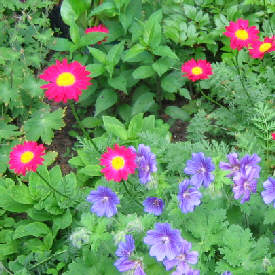
seen in the photo above with lovely blue-purple Geranium x magnificum
near: Nepeta x faassenii 'Dropmore Blue' (or other named varieties)
Chrysanthemum x morifolium 'El Toro': Garden Mum, red
now called: Dendranthema x grandiflorum
with: Ceratostigma plumbaginoides
If the choices above aren't sufficient for your purposes, try some of those at the links below.
pink Chrysanthemums
white Chrysanthemums
a Chrysanthemum with variegated foliage
DIANTHUS
 Commonly called Pinks, these perennials come in a multitude of sizes and colours, all with "pinked" edges from which the common name is derived. Plants are absolutely smothered with blooms at various times of the gardening season depending on the species. Most thrive in full sun with well-drained, slightly acidic soil. Divide them every 2-3 years. Keep clumps dead-headed for a tidier appearance. Some forms are highly fragrant.
Dianthus barbatus: Sweet William, crimson
Commonly called Pinks, these perennials come in a multitude of sizes and colours, all with "pinked" edges from which the common name is derived. Plants are absolutely smothered with blooms at various times of the gardening season depending on the species. Most thrive in full sun with well-drained, slightly acidic soil. Divide them every 2-3 years. Keep clumps dead-headed for a tidier appearance. Some forms are highly fragrant.
Dianthus barbatus: Sweet William, crimson
in front of: Lupinus 'Russell Hybrids' (separate or mixed colours)
Dianthus deltoides: Maiden Pinks, red
with: Anemone sylvestris (Snowdrop Anemone ) & Myosotis alpestris 'Victoria Dark Blue'
Dianthus deltoides 'Zing' or 'Zing Rose': deep rose-red

seen above at the front of a rock-edged bed, falling forward onto a red Sempervivum tectorum below
in front of: Iris x germanica, Paeonia
beside: Thymus x citriodorus, Euphorbia epithymoides
with: Veronica spicata 'Nana'
Many more forms and colours of Dianthus can be found at the links below. Use the partnership ideas to help prepare your list of new plants to look for next year.
Dianthus as edgers
pink Dianthus
silver foliage Dianthus
white Dianthus
yellow Dianthus
GAILLARDIA
  Blanket Flower is a daisy that comes in several colours and colour combinations, including red. Flower petals overlap giving them a jagged appearance. Full sun and average, well-drained soil suit them best. Divide every 2-3 years in early spring.
Gaillardia x grandiflora 'Burgundy': Blanket Flower, deep wine-red, 2-3'
Blanket Flower is a daisy that comes in several colours and colour combinations, including red. Flower petals overlap giving them a jagged appearance. Full sun and average, well-drained soil suit them best. Divide every 2-3 years in early spring.
Gaillardia x grandiflora 'Burgundy': Blanket Flower, deep wine-red, 2-3'
with: red Salvia, yellow Coreopsis, Chrysanthemum x superbum
echo with: the purple of a bold purple Canna
Add extra oomph to your gardens with the ideas available about Blanket Flower at the following links.
various Gaillardia
yellow Gaillardia
HEMEROCALLIS
 With thousands of registered Daylily cultivars to choose from you are sure to find many that suit your fancy. Flowers appear on stalks arising from strappy foliage. Each flower lasts only a day so there is plenty of dead-heading required to keep clumps looking tidy. After all blooming is over, cut spent stalks back to below the foliage or to the ground.
Some of the daylilies below are Spider and Unusual Form Daylilies. Follow the link to learn more about the beautiful cultivars available in these two classes and see images that show their amazing appearance. You will also discover how to find suppliers of these classes in your area.
Hemerocallis: Daylily, red
With thousands of registered Daylily cultivars to choose from you are sure to find many that suit your fancy. Flowers appear on stalks arising from strappy foliage. Each flower lasts only a day so there is plenty of dead-heading required to keep clumps looking tidy. After all blooming is over, cut spent stalks back to below the foliage or to the ground.
Some of the daylilies below are Spider and Unusual Form Daylilies. Follow the link to learn more about the beautiful cultivars available in these two classes and see images that show their amazing appearance. You will also discover how to find suppliers of these classes in your area.
Hemerocallis: Daylily, red
with: Perilla frutescens (an annual herb with black-purple foliage)
with: Heliopsis helianthoides 'Summer Sun'
Hemerocallis: rust red
with: Verbascum chaixii 'Album', Centaurea macrocephala, yellow Turk's cap lilies & Alchemilla mollis
Hemerocallis 'Carolina Octopus': deep vibrant red with green eye and throat, scape height 28", bloom 10"

this Spider daylily cultivar was registered in 2002, season E, Spider Ratio 4.17:1
Hemerocallis 'Gordon Biggs': raspberry-red

with: Alchemilla mollis, Campanula, Delphinium, Echinacea purpurea,Shasta Daisy, Salvia nemorosa
Hemerocallis 'Parade of Peacocks': rose peach with rose eyezone and cream throat
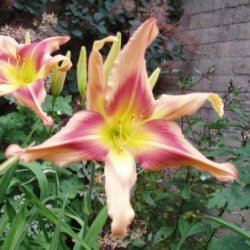
this Unusual Form Crispate cultivar was registered in 1990, scape height 36", bloom 8", bloom season MLa
Hemerocallis 'Raspberry Pixie'
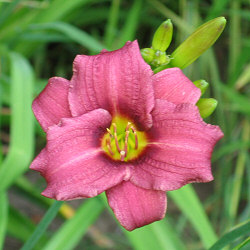
the flower of this daylily cultivar is quite tiny, the colour wonderful
with: Astilbe 'Ostrich Plume'
Hemerocallis 'Rosy Lights': rose beige with deep rose eyezone & greenish yellow throat, scape height 40", bloom 8.5"

this Unusual Form Crispate daylily cultivar was registered in 1990, bloom season MLa
Hemerocallis 'Shining Plumage': a rich red
combined with: Hemerocallis 'Sparks' (brilliant red-orange ), Hemerocallis 'Bright Banner' & Linum perenne
The choices of Daylilies available today are staggering in number. Perhaps some of the combinations suggested at the following links might provide inspiration as you plan additions for next year.
various Daylilies
orange Daylilies
pink Daylilies
purple Daylilies
Spider and Unusual Form Daylilies
white Daylilies
yellow Daylilies
HEUCHERA
  Coral Bells or Alumroot is a wonderful foliage perennial for a wide range of exposures, from full sun to partial shade, always preferring moist well-drained and humus-rich soil. Too much shade may reduce flowering. Because clumps gradually push their way out of the ground, lift and divide them every 3 years, replanting only healthy outer rosettes firmly into amended soil.
Heuchera: Coral Bells, red
Heuchera 'Pluie de Feu': cherry-red
Coral Bells or Alumroot is a wonderful foliage perennial for a wide range of exposures, from full sun to partial shade, always preferring moist well-drained and humus-rich soil. Too much shade may reduce flowering. Because clumps gradually push their way out of the ground, lift and divide them every 3 years, replanting only healthy outer rosettes firmly into amended soil.
Heuchera: Coral Bells, red
Heuchera 'Pluie de Feu': cherry-red
with: Astrantia major, Iris sibirica 'Little White', Geranium 'Ballerina'
Heuchera sanguinea 'Irish Mist': red variegated form
in part shade with: variegated Hosta, bronze forms of Ajuga
in more sun with: Penstemon digitalis 'Husker Red', Salvia officinalis 'Purpurascens' or annual Perilla frutescens
Heuchera sanguinea 'Snow Storm': cerise, bright variegation in foliage
in part shade with: bronze forms of Ajuga
in more sun with: Penstemon digitalis 'Husker Red', Salvia officinalis 'Purpurascens' or annual Perilla frutescens
combined with: Heuchera 'Cherry Splash' & Heuchera 'Montrose Ruby'
Learn about the planting and maintenance of Coral Bells as well as what other perennials make suitable companions at the links that follow.
Coral Bells as edgers
pink Coral Bells
purple Coral Bells
silver foliage Coral Bells
white Coral Bells
Coral Bells to attract Hummingbirds
Coral Bells with variegated foliage
IRIS
 Choices in the Iris genus are almost unlimited, in height, colour as well as type. Different species require very different growing conditions so learn what suits your own plants for best results. Because the Iris borer can be a serious problem, never compost Iris foliage or indeed any part of Iris plants.
Iris: dark red
Choices in the Iris genus are almost unlimited, in height, colour as well as type. Different species require very different growing conditions so learn what suits your own plants for best results. Because the Iris borer can be a serious problem, never compost Iris foliage or indeed any part of Iris plants.
Iris: dark red
with: Tradescantia 'Zwanenburg Blue' (deep violet-purple ) or 'Snowcap' (pure white )
Iris ensata 'Wine Ruffles': Japanese Iris, dark wine-red, 4'
with: paler Iris ensata 'Queen of Blues'
You've admired them in other people's gardens but have only a few tired old ones in your own. Now is the time to consider the many choices you have in finding forms that will give your gardens more appeal to those that come calling. See the links below for examples.
blue Iris
bulbous Iris forms
Iris as edgers
orange Iris
purple Iris
white Iris
yellow Iris
Iris with variegated foliage
KNAUTIA
 Crimson Scabious, hardy to Zone 5, is a bushy perennial with double pincushion-type flowers. The flowers, on long stalks, can be allowed to flop forward over a garden edge for added charm. Give this plant full sun and average well-drained soil. I got a division from a friend after admiring it in her garden. The rich raspberry shade is wonderful. It started to bloom July 9 and continued until late October when everything had to be cut back for the winter. Quite a performance.
Knautia macedonica: Crimson Scabious, wine-red
Crimson Scabious, hardy to Zone 5, is a bushy perennial with double pincushion-type flowers. The flowers, on long stalks, can be allowed to flop forward over a garden edge for added charm. Give this plant full sun and average well-drained soil. I got a division from a friend after admiring it in her garden. The rich raspberry shade is wonderful. It started to bloom July 9 and continued until late October when everything had to be cut back for the winter. Quite a performance.
Knautia macedonica: Crimson Scabious, wine-red

synonym: Scabiosa rumelica
seen above with: white Delphinium 'Galahad' & purple Clematis 'Polish Spirit'
note: follow the link for a profile of Knautia macedonica
with: pure white Delphinium 'Galahad'
with: silver Artemisia, deep green shrubs
LILIUM
A wide range of colours, sizes and forms makes the Lily one of the most sought-after perennials of summer. Growing from bulbs, they send up stalks that are clothed with leaves and topped by variously-shaped flowers depending on type. If you don't intend to save seeds, always remove spent flowers. Divide clumps in late summer to fall as they enter dormancy, being sure to replant bulbs immediately.
Lilium: dark red Asiatic Lily
combined with: Veronica (V. longifolia, V. 'Sunny Border Blue', 'Goodness Grows' or 'Romily Purple') & double
Lilium: warm red
with: Aconitum x bicolor 'Bicolor'
Lilium: ruby or rose-coloured
Lilium: wine-red
with: Campanula carpatica 'Blue Clips' or 'White Clips'
Add richness to your garden beds with any of the Lily forms on the pages below, with the plant partners suggested by the gardening experts.
orange Lilies
pink Lilies
white Lilies
yellow Lilies
LUPINUS
 As much as I admire the Lupine in other people's gardens, I have never had any success in my own, in spite of trying different growing conditions and soil types. They apparently prefer rich, moist, well-drained soil, on the acidic side. Cool summer temperatures are apt to provide best performance. Plants may be short-lived in areas with hot summers.
Lupinus polyphyllus 'Popsicle Red': Washington Lupine
As much as I admire the Lupine in other people's gardens, I have never had any success in my own, in spite of trying different growing conditions and soil types. They apparently prefer rich, moist, well-drained soil, on the acidic side. Cool summer temperatures are apt to provide best performance. Plants may be short-lived in areas with hot summers.
Lupinus polyphyllus 'Popsicle Red': Washington Lupine
with: Paeonia, Iris, Campanula spp.
Learn more about lupines including their ability to draw hummingbirds to your gardens at the link below.
Lupines to attract Hummingbirds
LYCHNIS
Campion, also called Catchfly, is a short-lived yet showy perennial. Because the flower colour is often so vivid, you can't go wrong by surrounding plants with lots of green. Spring division every 2-3 years is recommended.
Lychnis: Campion, red forms
where: among green-coloured plants
with: yellow and soft blue flowers ie. Perovskia atriplicifolia, Rudbeckia, Achillea, Anthemis tinctoria, Delphinium
For more plants in this genus, visit the links below and try some of the suggested plant combinations for extra effect.
orange Lychnis
pink Lychnis
Lychnis with silver foliage
white Lychnis
MONARDA
  Another perennial with aromatic foliage, Bee Balm also has tubular flowers that are loved by hummingbirds. Provide moist, humus-rich soil in full sun to part shade and never let this plant dry out. Division every 2-3 years will keep your plants vigorous. Good air circulation will help prevent powdery mildew.
Monarda didyma: Bee Balm, Bergamot, red
Monarda didyma 'Cambridge Scarlet': brilliant scarlet
Monarda didyma 'Gardenview Scarlet': brilliant red
Do you have any island beds? Tall Bee Balms make wonderful plants for the middle of such beds, surrounded by shorter perennials, many of which are recommended by gardening experts at the links below.
numerous Bee Balm forms
blue Bee Balm
pink Bee Balm
white Bee Balm
Another perennial with aromatic foliage, Bee Balm also has tubular flowers that are loved by hummingbirds. Provide moist, humus-rich soil in full sun to part shade and never let this plant dry out. Division every 2-3 years will keep your plants vigorous. Good air circulation will help prevent powdery mildew.
Monarda didyma: Bee Balm, Bergamot, red
Monarda didyma 'Cambridge Scarlet': brilliant scarlet
Monarda didyma 'Gardenview Scarlet': brilliant red
Do you have any island beds? Tall Bee Balms make wonderful plants for the middle of such beds, surrounded by shorter perennials, many of which are recommended by gardening experts at the links below.
numerous Bee Balm forms
blue Bee Balm
pink Bee Balm
white Bee Balm
PAEONIA
 Late spring and early summer would not be the same without the presence of Peonies in our gardens. Full sun and moist soil, especially when buds are forming, fulfills their needs. Failure to bloom is often the result of being planted too deeply. Eyes should be no more than 1-2" below the soil surface.
Paeonia: Peony, crimson
Late spring and early summer would not be the same without the presence of Peonies in our gardens. Full sun and moist soil, especially when buds are forming, fulfills their needs. Failure to bloom is often the result of being planted too deeply. Eyes should be no more than 1-2" below the soil surface.
Paeonia: Peony, crimson
combined with: Geranium clarkei 'Kashmir White' & Iris x germanica (dark violet)
Paeonia: dark red


behind: Geranium sanguineum striatum, a pale pink (formerly G. s. lancastriense), Iris sibirica &
Thalictrum aquilegiafolium
with: Salvia 'Miss Indigo' (intense violet-blue)
Paeonia lactiflora: red


see this in person at:
Virginia's Garden, 1015 Dyers Bay Rd, Dyers Bay, Ontario, Canada
with: Narcissus (around base ), Iris x germanica (tall bearded)
over: Muscari
in front of: ferns
Paeonia tenuifolia: Fernleaf Peony
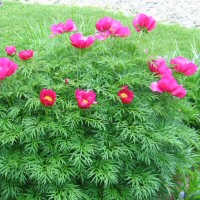
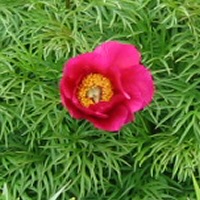
note: follow the link for a profile of the Fernleaf Peony
with: deep purple Aubrieta deltoidea, Geranium 'Album'
with: blue or purple Iris x germanica (dwarf bearded forms)
If you want to add more Peonies to your garden, check out some of the forms at the following links, and partner them as recommended for wonderful design.
pink Peony forms
white Peony forms
yellow Peony forms
PAPAVER
 Whichever species you choose, your Poppy flowers will have a papery appearance to them. And most will self-seed freely so there will never be a shortage of these beauties about the garden. The Oriental Poppies in particular are not especially attractive to deer.
Papaver orientale: Oriental Poppy, red forms
Whichever species you choose, your Poppy flowers will have a papery appearance to them. And most will self-seed freely so there will never be a shortage of these beauties about the garden. The Oriental Poppies in particular are not especially attractive to deer.
Papaver orientale: Oriental Poppy, red forms
with: Salvia pratensis (Meadow Sage, Clary Sage)
Papaver somniferum : Opium Poppy
with: just about anything - it pops up here and there around the garden and looks lovely wherever it is
Papaver somniferum: double forms

I dubbed this gorgeous one "Big Red" but alas it has disappeared from my garden
Papaver somniferum: single forms
Papery Poppies are available in other colours as you will see by following the links below.
orange Poppies
pink Poppies
Poppies with silver foliage
PHLOX
 This genus can range from tiny dwarf creepers to tall border types in a variety of colours including the red form below.
Phlox subulata 'Atropurpurea': Moss Pink, Moss Phlox, wine (carmine)
This genus can range from tiny dwarf creepers to tall border types in a variety of colours including the red form below.
Phlox subulata 'Atropurpurea': Moss Pink, Moss Phlox, wine (carmine)
with: Narcissus poeticus, Narcissus jonquilla, Iris x germanica (early dwarf forms)
in front of: Narcissus poeticus, Narcissus jonquilla, early yellow Narcissus
in front of: late Tulipa; Allium aflatunense & cultivar 'Purple Sensation'
combined with: Doronicum cordatum & Dicentra (pink or white)
with spring bloomers: Iberis sempervirens, Aubrieta (pink or white) & Arabis
Achieve the effect you want to create at garden edges, or in mid to rear border positions, by using any of the forms of Phlox described on the pages you can access below.
numerous Phlox forms
Phlox edgers
blue Phlox
orange Phlox
pink Phlox
Phlox for shade
white Phlox
Phlox with variegated foliage
POTENTILLA
 The perennial form of Cinquefoil is different from the shrub form so many people grow. It is an herbaceous perennial with 5-petalled flowers and hairy, divided leaves. Give it sun and well-drained soil.
Potentilla atrosanguinea 'Firedance': Himalayan Cinquefoil, salmon-red
The perennial form of Cinquefoil is different from the shrub form so many people grow. It is an herbaceous perennial with 5-petalled flowers and hairy, divided leaves. Give it sun and well-drained soil.
Potentilla atrosanguinea 'Firedance': Himalayan Cinquefoil, salmon-red
beside: Geranium himalayense
Potentilla nepalensis 'Miss Willmot': Nepal Cinquefoil, scarlet-red with lighter pink centre
combined with: Campanula carpatica 'China Doll' (azure blue), Sedum 'Dragon's Blood' & Thymus x citriodorus
with: Sedum, Linum perenne, Gypsophila
Perhaps the best known form of this perennial, 'Miss Willmot' can be seen in poetry form in our Garden of Verses - A Place in the Garden.
PRIMULA
 Our spring gardens are the richer for planting Primroses where we can. They detest both high heat and humidity and crave moisture. You must certainly keep them well watered during prolonged periods of drought. Light to partial shade suits them just fine. Division is best done immediately after they bloom.
Primula Pacific Giants Scarlet & Bright Red Shades: Primrose
Our spring gardens are the richer for planting Primroses where we can. They detest both high heat and humidity and crave moisture. You must certainly keep them well watered during prolonged periods of drought. Light to partial shade suits them just fine. Division is best done immediately after they bloom.
Primula Pacific Giants Scarlet & Bright Red Shades: Primrose
with spring bulbs: Tulipa, Galanthus, Narcissus
For additional choices try the link below.
yellow Primrose
SEDUM
Easy care is a quality of all the Stonecrops, including the one below. Most prefer full sun although the shorter species can tolerate partial shade. Divide them when necessary in spring or fall. Apparently only the Border Varieties attract butterflies.
Sedum spurium 'Dragon's Blood': Two-Row Sedum

seen above with the pink flower of a Filipendula flopped forward onto it - lovely!
in front of: Achillea x 'Moonshine'
in front of: Lilium regale (white), Achillea (cerise-red) & Delphinium (violet)
in front of: Lilium regale (white) & Veronica longifolia (any purple selection)
in front of: Iris pumila (yellow dwarf), Iris x germanica (medium height yellow), Iris x germanica (blue)
combined with: Campanula carpatica 'China Doll' (azure blue), Potentilla 'Miss Willmott' & Thymus x citriodorus
Rely on your own design sense as well as the recommendations of experts in choosing the correct Sedums for your site and suitable companions for them, accessed by clicking on the links below.
numerous Sedums
Sedums as edgers
white Sedums
yellow Sedums
Sedums with silver foliage
Sedums with variegated foliage
TRADESCANTIA
Spiderwort will frequently pop up around the garden, its three-petalled flowers, beginning in late spring, above jointed stems. Flowers last only half a day, closing up by early afternoon. Cut the foliage back after the first flush of flowers to tidy up the plant and you may well experience a second flush of bloom later in the season.
Tradescantia x andersoniana 'Red Cloud': Spiderwort, maroon-red
with: Tradescantia 'Pauline' (orchid-pink) or Tradescantia 'Snowcap' (pure white)
Not sure where or how to use members of the Spiderwort genus? Check out the links below for helpful information and lots of companionship ideas.
pink Spiderwort
white Spiderwort
TRILLIUM
Sometimes called Wake-robin or Birthroot, the Trillium is a beautiful early spring wildflower with large, showy flowers. Each rhizome sends up a single stem with 3 leaves and one 3-petalled flower. Most often associated with the colour white, the Trillium also has forms in deep maroon-red or purple-brown. This is a perfect plant to colonize in either a woodland or a shady garden. Performance will excel in a moist humusy soil with a pH level of 6.0 to 7.0.
Trillium: red Trillium, Stinking Benjamin, 8-16", May-June bloom, flower may have an unpleasant odor
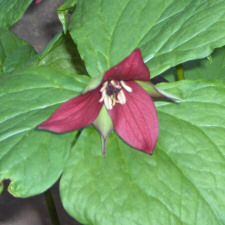
Other forms in red shades, or white that changes to pink or red, suggested on the Fraser's Thimble Farm page that you might want to research include:
- Trillium catesbaei: Rosy Trillium, pink-to-rose flowers
- Trilllium chloropetalum giganteum rubra: large up-pointing dark red petals, handsome mottled leaves
- Trillium cuneatum: Whippoorwill Flower, flowers dark maroon to brown
- Trillium erectum: Purple Trillium, purple-red flower, petals nearly erect
- Trillium kurabayashii: fragrant purple-red flowers, well mottled leaves
- Trillium ovatum: fragrant white flowers age to pink then to wine-purple
- Trillium pusillum: Dwarf White Trillium, white flowers age to cherry red
- Trillium recurvatum: Prairie Trillium, brown-red flowers, mottled leaves
- Trillium stamineum: flowers usually very dark red purple
- Trillium sulcatum: Southern Red Trillium, typically rich maroon red but sometimes red, yellow, pink or white
- Trillium vaseyi: large red nodding flowers, a beautiful species
More Trilliums, information about growing them well and finding perfect plant partnerships for them can be found at the pages below.
- Trilliums in shade
- Trilliums with variegated foliage
TULIPA
Tulips are wonderful spring-blooming bulbs, available in a variety of heights, shapes and colours including the red shades below. They require lots of water and food during their active growth period in spring, followed by a dry dormancy period during summer. Most prefer full sun and humus-rich soil.
Tulipa: Tulip, bright red
Tulipa: crimson and/or rose
Tulipa: red
Tulipa: late-blooming red
Tulipa: scarlet (a warm red leaning to orange)
Tulipa 'Little Beauty': dark red, blue eyes, 2-3" dwarf
Tulipa 'Mariette': deep rose 25" Lily-Flowered (Mid-season) Tulip
Tulipa 'Red Emperor': 18" Fosteriana Tulip (Early)
Tulips in dozens of forms appear on several other pages on this site. Try them all to find something to suit your location or to partner with other spring-blooming bulbs in your gardens.
myriad Tulips
white Tulips
orange Tulips
Tulips with variegated foliage
VERONICA
 Veronica, also commonly called Speedwell, has choices both tall and short, all with flowers that have 4-5 petals, with a variety of foliage shapes depending on type. Available in white, purple shades, blue, pink and even some red as you will see below.
Veronica spicata 'Red Fox': Spike Speedwell, deep rose pink
Add richness to your plantings with the plant partnership suggestions of gardening experts at the links below.
Veronica, also commonly called Speedwell, has choices both tall and short, all with flowers that have 4-5 petals, with a variety of foliage shapes depending on type. Available in white, purple shades, blue, pink and even some red as you will see below.
Veronica spicata 'Red Fox': Spike Speedwell, deep rose pink
Add richness to your plantings with the plant partnership suggestions of gardening experts at the links below.
Veronica as edgers
pink Veronica
purple Veronica
Veronica with silver foliage
white Veronica
All of our own Gardens By The Bay pages can be accessed by clicking on the links below.
HOME
GARDEN POETRY |
GARDEN POETRY MUSE
GEORGIAN BAY VIEW
BOTANICAL LATIN - BASICS
COLOR THEORY
THE GARDENS
CORNER GARDEN CONSTRUCTION |
CORNER GARDEN PLANTING |
LONG GARDEN
EAST GARDEN |
HOSTA GARDEN |
NORTH GARDEN |
WINTER GARDENS
PLANT PARTNERSHIPS
BLUE PERENNIALS Aconitum -
Geranium |
Iris - Vinca
BULBS Allium - Hyacinthus |
Narcissus only |
Tulipa only |
Minor Bulbs
BUTTERFLY MAGNETS Anaphalis - Hemerocallis |
Liatris - Veronicastrum
 DAYLILIES Spider & Unusual Form DAYLILIES Spider & Unusual Form EDGERS Arabis - Iris |
Nepeta - Veronica
FOLIAGE PERENNIALS
Alchemilla - Tanacetum
HOSTA Hosta - all
HUMMINGBIRD-FRIENDLY PERENNIALS Alcea - Salvia
ORANGE PERENNIALS Achillea - Tulipa
ORNAMENTAL GRASSES Acorus - Imperata |
Miscanthus - Spodiopogon
PINK PERENNIALS Achillea - Lilium |
Lychnis - Veronica
PURPLE PERENNIALS Aconitum - Liatris |
Polemonium - Veronica
RED PERENNIALS Achillea - Veronica
SHADE PERENNIALS Aegopodium - Erythronium |
Ferns - Polemonium |
Polygonatum - Vinca
SILVER FOLIAGE PERENNIALS
Achillea - Cerastium
|
Cornus - Limonium
|
Lunaria - Veronica
SIMPLY SPECIAL PERENNIALS Acanthus - Saxifraga
WHITE PERENNIALS Achillea - Iris |
Kalimeris - Yucca
YELLOW PERENNIALS Achillea - Hypericum |
Inula - Verbascum
VARIEGATED-FOLIAGE PERENNIALS Acorus - Erythronium |
Hakonechloa - Lysimachia |
Miscanthus - Yucca
PLANT PROFILES
Dianthus 'Tiny Rubies' |
Geranium |
Geum coccineum |
Kerria japonica |
Knautia macedonica
Paeonia tenuifolia |
Papaver somniferum |
Rudbeckia |
Salvia 'East Friesland'
Trollius |
Veronica 'Sunny Border Blue'
PROPAGATION
DIVISION - SPRING ONLY |
DIVISION - FALL ONLY |
DIVISION - SPRING OR FALL |
DO NOT DIVIDE
FERTILIZATION
EDGERS Arabis - Iris |
Nepeta - Veronica
FOLIAGE PERENNIALS
Alchemilla - Tanacetum
HOSTA Hosta - all
HUMMINGBIRD-FRIENDLY PERENNIALS Alcea - Salvia
ORANGE PERENNIALS Achillea - Tulipa
ORNAMENTAL GRASSES Acorus - Imperata |
Miscanthus - Spodiopogon
PINK PERENNIALS Achillea - Lilium |
Lychnis - Veronica
PURPLE PERENNIALS Aconitum - Liatris |
Polemonium - Veronica
RED PERENNIALS Achillea - Veronica
SHADE PERENNIALS Aegopodium - Erythronium |
Ferns - Polemonium |
Polygonatum - Vinca
SILVER FOLIAGE PERENNIALS
Achillea - Cerastium
|
Cornus - Limonium
|
Lunaria - Veronica
SIMPLY SPECIAL PERENNIALS Acanthus - Saxifraga
WHITE PERENNIALS Achillea - Iris |
Kalimeris - Yucca
YELLOW PERENNIALS Achillea - Hypericum |
Inula - Verbascum
VARIEGATED-FOLIAGE PERENNIALS Acorus - Erythronium |
Hakonechloa - Lysimachia |
Miscanthus - Yucca
PLANT PROFILES
Dianthus 'Tiny Rubies' |
Geranium |
Geum coccineum |
Kerria japonica |
Knautia macedonica
Paeonia tenuifolia |
Papaver somniferum |
Rudbeckia |
Salvia 'East Friesland'
Trollius |
Veronica 'Sunny Border Blue'
PROPAGATION
DIVISION - SPRING ONLY |
DIVISION - FALL ONLY |
DIVISION - SPRING OR FALL |
DO NOT DIVIDE
FERTILIZATION
BULBS |
ORNAMENTAL GRASSES |
PERENNIALS |
SHRUBS |
VINES
LINKS
GARDENS |
LOCAL GARDENS |
BOTANICAL TERMINOLOGY
GARDENING BOOKS |
NON-GARDENING
HOME
|